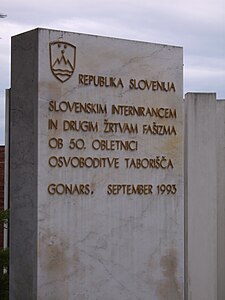| Gonars | |
|---|---|
| Italian concentration camp | |
 Monument for Slovene victims | |
| Location | Gonars, Kingdom of Italy |
| Operated by | Italian Ministry of the Interior |
| Commandant | Lieutenant Colonel Eugenio Vicedomini, Cesare Marioni, Ignazio Fragapane, Gustavo De Dominicis, Arturo Macchi[1] |
| Operational | 23 February 1942 – 8 September 1943 |
| Inmates | Mostly ethnic Slovene and Croat civilians |
| Number of inmates | 10,000[2] (1943) |
| Killed | 500+ |
The Gonars concentration camp was one of the several Italian concentration camps and it was established on February 23, 1942, near Gonars, Italy.
Many prisoners were transferred to this camp from another Italian concentration camp, the Rab concentration camp, which served as equivalent of the final solution in Mario Roatta's ethnic cleansing policy against ethnic Slovenes from the Italian-annexed Province of Ljubljana and Croats from Gorski Kotar, in accord with the racist 1920s speech by Benito Mussolini, along with other Italian war crimes committed on the Italian-annexed territories of Yugoslavia:
When dealing with such a race as Slavic – inferior and barbarian – we must not pursue the carrot, but the stick policy.... We should not be afraid of new victims.... The Italian border should run across the Brenner Pass, Monte Nevoso and the Dinaric Alps.... I would say we can easily sacrifice 500,000 barbaric Slavs for 50,000 Italians....
The first transport of 5,343 prisoners (1,643 of whom were children) arrived two days after its establishment, on February 23, 1942, from the Province of Ljubljana and from two other Italian concentration camps, the Rab camp and the camp at Monigo (near Treviso).
The camp was disbanded on September 8, 1943, immediately after the Italian armistice.
Only in 1973 was a memorial created by the sculptor Miodrag Živković at the town's cemetery. The remains of 453 Slovenian and Croatian victims were transferred into its two underground crypts. It is believed that at least 50 additional persons died in the camp due to starvation and torture. At least 93 children were killed at the camp, including those that had been transferred from the Rab concentration camp to Gonars.[6]
- ^ "Gonars Concentration Camp". Retrieved 21 June 2022.
- ^ Herman Janež: Onstran žice – Gonars (2): Prihodi transportov s taborišniki (deutsch: Jenseits des Zaunes – Gonars (2): Die Ankunft der Gefangenentransporte), mehrteilige Reihe in der slowenischen Wochenzeitung Dolenjski list, Novo mesto, 9. August 2012, S. 18.
- ^ Pirjevec, Jože (2008). "The Strategy of the Occupiers". Resistance, Suffering, Hope: The Slovene Partisan Movement 1941–1945 (PDF). p. 27. ISBN 978-961-6681-02-5.
- ^ Verginella, Marta (2011). "Antislavizmo, rassizmo di frontiera?". Aut aut (in Italian). Il Saggiatore. ISBN 978-88-6576-106-9.
- ^ Santarelli, Enzo (1979). Scritti politici: di Benito Mussolini; Introduzione e cura di Enzo Santarelli (in Italian). p. 196.
- ^ "Održana komemoracija na Spomen groblju Kampor". Retrieved 2 July 2023.